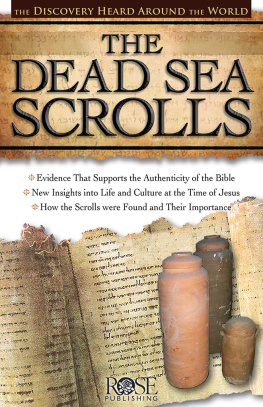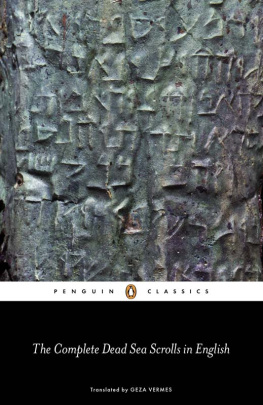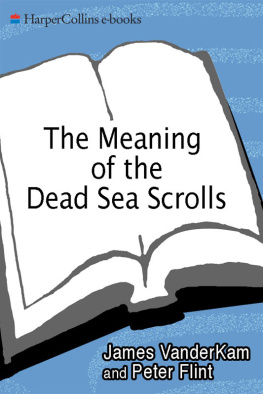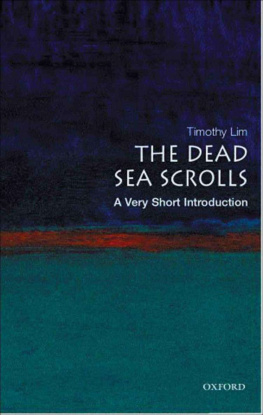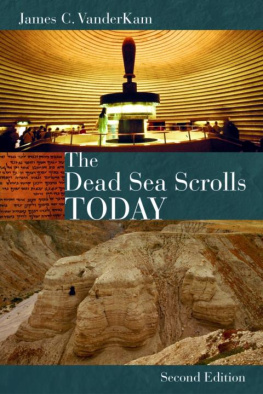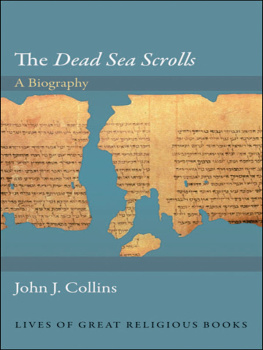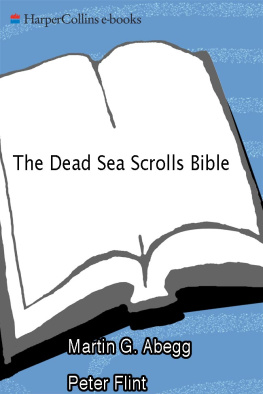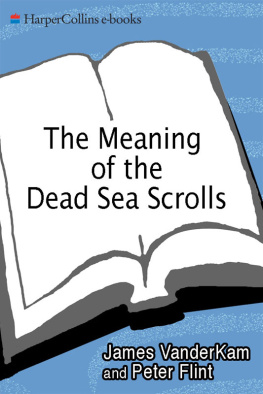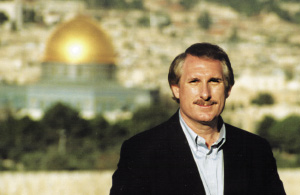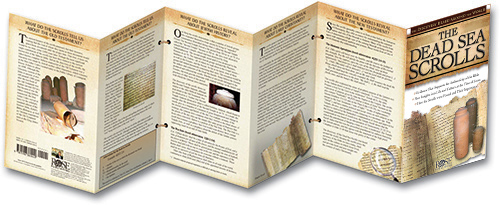The printed version of this eBook is the The Dead Sea Scrolls pamphlet, ISBN-13: 9781596360440
J. Randall Price, Ph.D, author of Secrets of the Dead Sea Scrolls and The Stones Cry Out: What Archaeology Reveals about the Truth of the Bible , is the Director of Excavations at the Qumran Plateau and is president of World of the Bible Ministries, Inc.
It is illegal to photocopy, transmit electronically, post on the internet, or reproduce this pamphlet in whole or in part in any form.
2005 World of the Bible Ministries
Rose Publishing, Inc.
4733 Torrance Blvd., #259
Torrance, California 90503 U.S.A.
Email: info@rose-publishing.com
www.rose-publishing.com
All rights reserved.
THE DEAD SEA SCROLLS
This handy eBook:
- Explains the fascinating (and prophetic) dream of King Nebuchadnezzar in Daniel 2 and Daniel's vision in chapter 7in an easy to understand way.
- Reveals what each of the statue's main parts represent from Nebuchadnezzar's dreamfrom its head of fine gold to its feet of iron and clay. (Uses an illustration based on an authentic Babylonian carving.)
- Shows what each of the beasts in Daniel 7 means, including the lion, bear, leopard, and beast of 10 horns.
- Features maps of ancient civilizations that make it easy to understand the kingdoms that are represented by the statue and Daniel's vision, and enjoy having a timeline of events and rulers (for all 4 kingdoms).
WHAT ARE THE DEAD SEA SCROLLS?
The Dead Sea Scrolls are a collection of 931 documents discovered over a half century ago in a region of the Judean desert in what is today called the West Bank. The scrolls date from different periodsas early as 300 BC to AD 40and were hidden in caves along the edge of the Dead Sea. The discovery of the Dead Sea Scrolls is the greatest literary and archaeological discovery of our time. The scrolls are not the original documents that make up the Hebrew Bible (the Old Testament), but they are the oldest copies of those documents that we have today. The Dead Sea Scrolls have shed new light on the practice of the Jewish religion during the periods when the books of the Bible were composed. They have given us a snapshot of the world Jesus ministered in with his twelve disciples. And they have helped us better understand the society in which the early church first started.
Location of Dead Sea Scrolls Discoveries
The scrolls are believed to be from the library of a group of first-century Jews who separated themselves from the rest of society by living out in the desert at a site known as Qumran. The scrolls contain a variety of writings: portions of every book of the Old Testament except the Book of Esther, commentaries on the books of the Bible, rules for religious rituals and community life, texts designed to prepare the Qumran sect for a war at the End of Time, marriage contracts, deeds of sale, calendars, horoscopes, and writings that claimed to foretell the future.
The texts are composed in three languagesHebrew, Aramaic, and Greek. They are written on leather parchment (made from goat or sheep skins) and papyrus (a form of early paper). One scroll is inscribed on pure copper and is known as the Copper Scroll. It appears to be a treasure map, detailing directions to 66 places throughout the Judean desert where immense amounts of gold, silver, and other precious items were hidden. Due to the secretive and mysterious way the texts were written and the loss of identifying physical features in the region today, all attempts to locate the treasure have thus far proven unsuccessful.
Qumran Manuscripts, which are copies of Books of the Old Testament
HOW WERE THE SCROLLS DISCOVERED?
In 1946, shepherds of the Ta'amireh Bedouin tribe settled in a desert area between Bethlehem and the Dead Sea, where they tended their flocks and herds. According to local hearsay, a teenager by the name of Muhammed edh-Dhib ("Muhammed the Wolf") went in search of a stray goat. Believing it to have wandered into one of the caves that honeycombed the limestone cliffs, he threw a rock into the cave to scare it out. Instead of hearing the bleat of a goat, he heard the sound of breaking pottery.
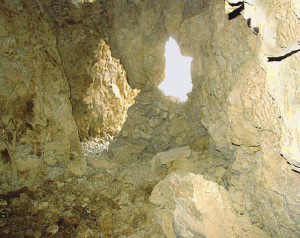
Inside Cave 1
He climbed up into what is today called Cave 1 and found ancient clay storage jars filled with seven scrolls. Four of these scrolls were sold in Bethlehem to an antiquities dealer known as Kando. He in turn sold them for $97.20 to the archbishop of the Monastery of St. Mark's in Jerusalem, the Metropolitan (a high office in the priesthood of the Syrian Orthodox Church) Mar Athanasius Yeshue Samuel. The other three were sold to Feidi Salahi, another antiquities dealer in Bethlehem, who in turn sold them to Hebrew University Professor Eleazar Sukenik in Jerusalem.
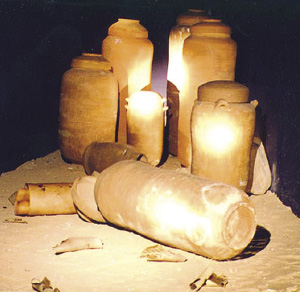
The Bedouin shepherds searched more caves, bringing most of their finds to Kando. Meanwhile, the Metropolitan permitted John Trever of the American Schools of Oriental Research to publish news and photographs of the find to the world in April 1948. Soon after, British archaeologists conducted a careful survey of the region and discovered several other caves with scrolls, including those along a terrace at Qumran. Of these, Cave 4 yielded approximately 15,000 fragments representing some 600 manuscripts. These were not found in storage jars but beneath the cave floor, indicating a rapid burial because of impending dangerperhaps the Roman invasion of Jewish territory in AD 68 that led two years later to the complete destruction of Jerusalem. Cave 7 was also unique in that it contained the fragments of 19 texts in Greekthe same language used to write the New Testament.
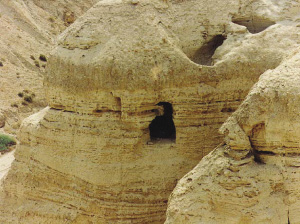
Cave 4
When the Arab-Israeli war broke out in 1948, the Metropolitan took his four scrolls to the United States and offered them for sale in an ad in the Wall Street Journal . Yigael Yadin, an archaeologist and the son of Professor Sukenik, anonymously purchased the scrolls for the State of Israel for $250,000. Later these four scrolls and three others were put on public display at the Shrine of the Book, a museum built in Jerusalem especially for scrolls. The State of Israel also houses other scrolls in a climate-controlled basement of the Rockefeller Museum in Jerusalem. Some scrolls are located in other countries, such as the Copper Scroll in the Citadel Museum in Amman, Jordan.
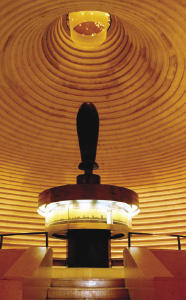
Shrine of the Book
WHAT DO WE KNOW ABOUT THE SITE OF THE SCROLLS?
Many of the scrolls were found in Caves 4-10 along the terrace known as Qumran, where archaeologists were quick to notice ancient ruins of buildings. Because the caves would have only been accessible via the Qumran plateau, archaeologists began to investigate a connection between the scrolls and the site. Archaeologist Roland de Vaux supported the connection with his discovery of pottery kilns that were used to fire the scroll jars and with his excavation of a two-story building that contained the remains of writing benches and ink wells. Roland deVaux (in the 1950s), Yitzhak Magen (in the 1990s), and Randall Price (as recently as 2005) have uncovered deposits of animal bones overlaid with sherds (broken pottery). The Dead Sea Scrolls speak of ritual meals, and several scholars contend that the animal bone deposits that were found buried in a ritual manner are the remains of these ritual meals.

